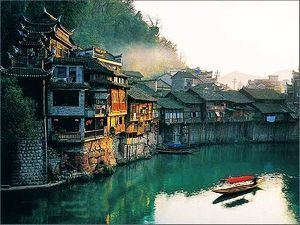Time zone China Standard (UTC+8) Local time Saturday 5:25 AM | Area 15,486 km² | |
 | ||
Country People's Republic of China Weather 18°C, Wind N at 5 km/h, 94% Humidity Points of interest Phoenix Ancient City, Aizhai Bridge, 沈从文故居 The Former R, Xiangxi Phoenix Ancient C, Xiongxiling Former Residence | ||
Fenghuang phoenix ancient town hunan china
Xiangxi Tujia and Miao Autonomous Prefecture (Chinese: 湘西土家族苗族自治州; pinyin: Xiāngxī Tǔjiāzú Miáozú Zìzhìzhōu) is an autonomous prefecture of the People's Republic of China. It is located in western Hunan province. It consists of 1 city, Jishou, and 7 counties: Baojing, Fenghuang, Guzhang, Huayuan, Longshan, Luxi, Yongshun. The capital is Jishou. Twenty-five nationalities gather here, of the total 2,480,000 population, 66.6 per cent are ethnic minorities, including 860,000 Tujia and 790,000 Miao.
Contents
- Fenghuang phoenix ancient town hunan china
- Map of Xiangxi Hunan China
- History
- Modern reforms
- Crop Production
- References
Map of Xiangxi, Hunan, China
History
Xiangxi has a long history. The land was sparsely inhabited during the Shang Dynasty, through the Warring States period up to the era of the Sui dynasty and Tang Dynasty. It fell under the influence of the Chu state during the Warring tates era. Later, it became part of the Western and Eastern han dyansty. After the collapse of the Han dynasty, it became under the control of the Shu Dynasty during the Three Kingdoms Period of China. Then the area became a subject of the Jin Dynasty. When the Yuan Dynasty was established, the region became a part of the Hubei province. Soon later, Hubei and Hunan province became one single province called Huchang (湖广). The Ming dynasty reestablished the Xiangxi Autonomous Prefecture and attached it to Hunan province.
Upon the establishment of modern China, the national government gave the region autonomous status and county level status. This meant that the control of the provincial government had less control over the region compared to other counties.
Modern reforms
Ever since the reforms by Deng Xiaoping, the region has developed substantially. The introduction of a large number of advanced production equipment and various types of automated production factories accelerated the growth of industries. In 2008, the total production value totaled 22,666 billion yuan.
Crop Production
Agricultural products such as rice, wheat, corn, soybeans, electricity, cement, wood, cigarettes, fertilizers, yarn and cloth became primary products.
